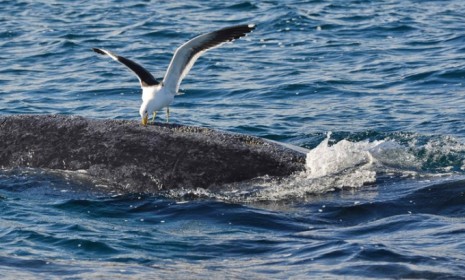The flesh-eating seagulls that are attacking whales
Off Argentina's coast, the birds have trained themselves to swoop down on the endangered mammals to feast on their blubber when they surface for air

The waters off Argentina's Chubut province have historically been a prime breeding spot for endangered Southern right whales. But now the gentle, bus-sized mammals are being threatened by a savvy new predator: Ravenous seagulls that swoop down when the whales surface to breathe, tearing and pecking away at their flesh for an easy meal. The attacks have become such a problem that local officials are declaring "open season" on the gulls. Here, a concise guide to this unusual battle:
What's going on exactly?
"The macabre torment of the whales sounds like a punishment from vengeful gods in a Greek myth or the plot of an Edgar Allan Poe story," says Tim Wall at Discovery. About eight years ago, the gull population near the coastal city of Puerto Madryn began to explode, and some of the birds figured out that the whales provided an accessible, rich source of meat. The gulls wait patiently for a whale to breathe, "then tear holes in the whale's flesh and rip off pieces of skin and blubber."
The Week
Escape your echo chamber. Get the facts behind the news, plus analysis from multiple perspectives.

Sign up for The Week's Free Newsletters
From our morning news briefing to a weekly Good News Newsletter, get the best of The Week delivered directly to your inbox.
From our morning news briefing to a weekly Good News Newsletter, get the best of The Week delivered directly to your inbox.
How problematic are the birds?
The attacks are causing the whales to change their natural behavior, making them increasingly hesitant to surface. They used to leap out of the water in dramatic displays; now, they simply skim the surface just quickly enough to catch a breath and retreat back to deeper waters. "It really worries us because the damage they're doing to the whales is multiplying, especially to infant whales that are born in these waters," says Marcelo Bertellotti of the National Patagonia Center, a government-sponsored conservation group. Experts also fear that the birds could affect the local tourism industry, changing whale-watching from "a magical experience to something from a horror movie," says Australia's Sky News.
Why are there so many gulls?
Human-made garbage. Open air trash heaps near coastal cities "have fueled a massive population boom in seagulls" by providing a huge new food source, says Discovery's Wall. Compounding the problem are fishermen who throw used fish parts — which seagulls eat — back into the ocean.
A free daily email with the biggest news stories of the day – and the best features from TheWeek.com
So now people are going to kill all the seagulls?
Not all of them. The tentative plan is for police to go out on motorboats to selectively shoot at gulls only when they're attacking the whales. Officials hope that this will eliminate the portion of the bird population that has been raised to feast on whale flesh. After the gulls are shot, however, their bodies must be quickly gathered to keep other marine life from swallowing them and their ammunition, which could cause further damage to the marine ecosystem. Some environmentalists, of course, vehemently oppose the plan, and are proposing alternatives, such as closing nearby garbage dumps and prohibiting fishermen from discarding their fish scraps in the ocean.
-
 US citizens are carrying passports amid ICE fears
US citizens are carrying passports amid ICE fearsThe Explainer ‘You do what you have to do to avoid problems,’ one person told The Guardian
-
 All roads to Ukraine-Russia peace run through Donetsk
All roads to Ukraine-Russia peace run through DonetskIN THE SPOTLIGHT Volodymyr Zelenskyy is floating a major concession on one of the thorniest issues in the complex negotiations between Ukraine and Russia
-
 Why is Trump killing off clean energy?
Why is Trump killing off clean energy?Today's Big Question The president halts offshore wind farm construction